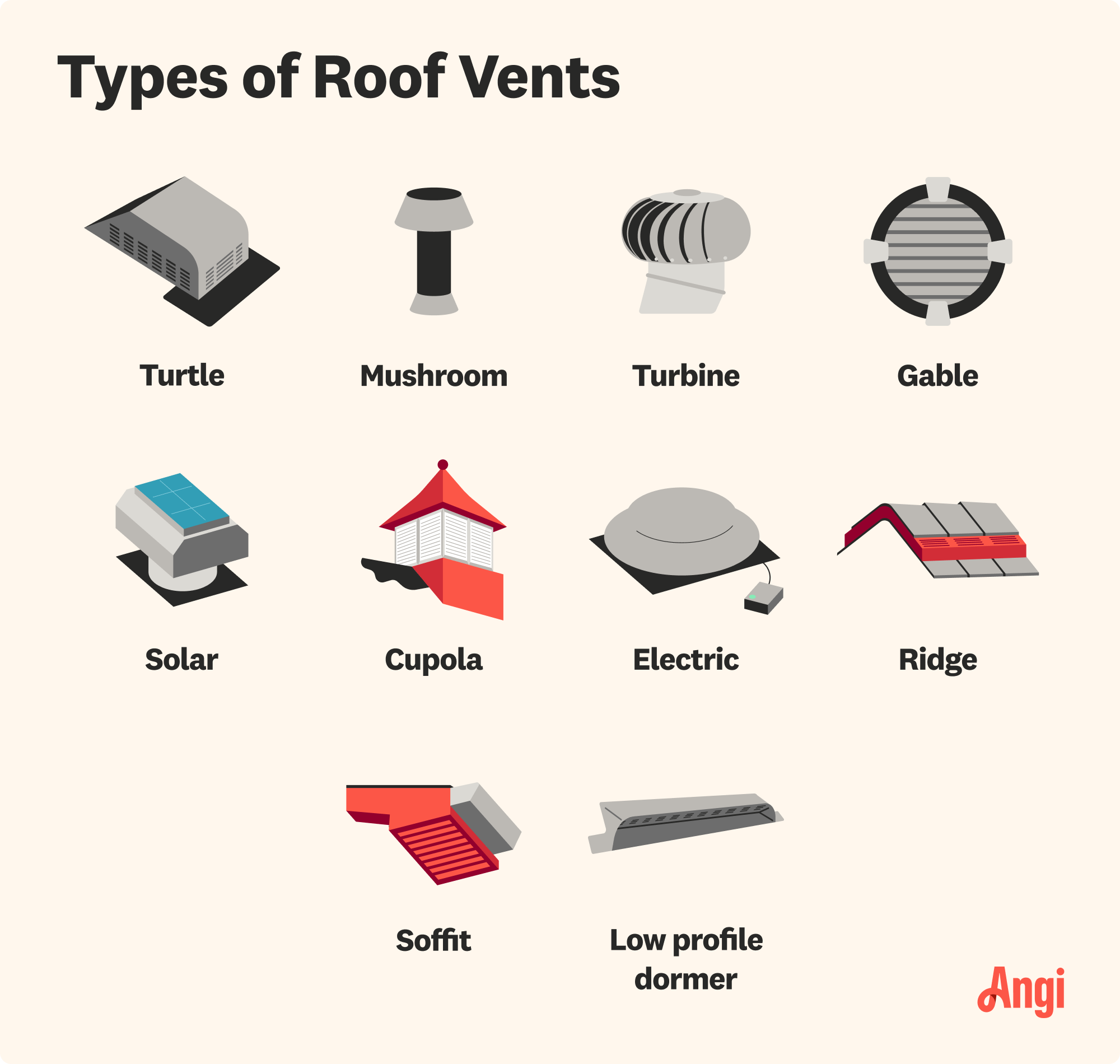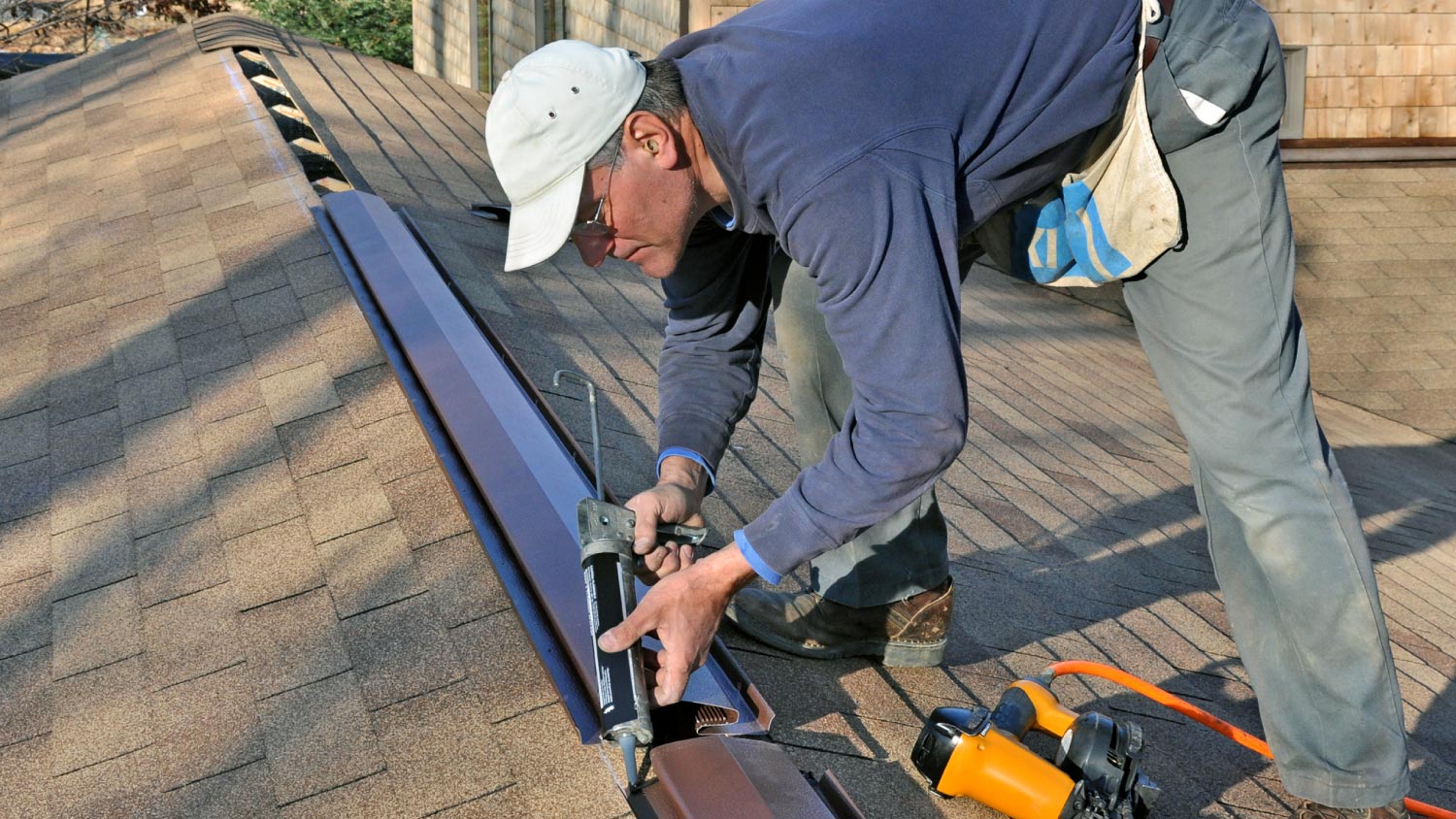
Dealing with a visibly damaged roof or leak? Learn about roof repair costs in Columbus to see how much you’ll need to budget for a permanent solution.
Improve the airflow in your attic without sacrificing curb appeal


Roof ridge vents are installed along the peak of the roof.
They improve airflow and extend a roof’s lifespan.
Ridge vents with baffles offer better protection against wind, rain, snow, and insects.
Ridge vents cost between $300 and $650 to install, on average.
When you’re searching for the best roof vent for your home to keep the air flowing in and the moisture out, you’ll likely come across ridge vents. In this guide, learn the benefits of ridge vents plus their cons and estimated costs.
Ridge vents are installed along the ridge, or peak, of the roof. Placed at the highest point of the roof, these vents help to control airflow in the attic by drawing warm air and moisture out, allowing air circulation.
Ridge vents are installed over an air slot that is cut directly into the roof deck and typically runs the entire length of the ridge. Once installed, it is covered with the roofing material which helps it blend into the roof.
Like your kitchen or bathroom, your roof needs ventilation to extend its life span and control temperatures. Proper roof ventilation helps reduce HVAC costs and prevents ice dams and moisture damage. A roof repair pro can assess your roof and make recommendations.
There are two types of ridge vents: ones with a baffle and ones without a baffle, and the one you choose will depend on your particular roof and its needs. Most ridge vents in areas that get regular rain or snow use baffles.
A ridge vent with a baffle uses an external baffle to deflect rain, wind, snow, insects, and debris, keeping it from entering the vent and, ultimately, the attic.
Ridge vents without baffles reduce the suction that roof vents with baffles create. Air is allowed to flow into the ridge vent, which prevents warm air from escaping or only allows it to escape from one side of the vent.
| Pros | Cons |
|---|---|
| Better attic airflow | Potential leakage |
| Good aesthetics | Tricky DIY install |
| Increased roof life | Won’t fit some roofs |
| Blocks insects | Snow penetration |
| Dissipates humidity | Costlier upfront |
If you have heat or humidity buildup in your attic, the biggest benefit of roof ridge vents is their ability to improve airflow in this space. If left unchecked, heat and humidity could cause mold and mildew in your attic, as well as an unpleasant, musty smell. As mold and mildew build up, your roof may suffer unnecessary rot damage, necessitating replacement.
The design of the roof ridge vents won’t detract from the look of your home or roof. They have a low profile that’s not obvious at a glance, unlike some other designs. Additionally, insects cannot penetrate these seamless-style vents.
However, the roof ridge vent design could allow snow or rain to penetrate, especially when high winds are driving the precipitation. Following the proper installation technique is key to reducing issues with this type of moisture penetration. Certain roof design styles, such as hip roofs, do not work well with roof ridge vents. Gable roof designs tend to accommodate this kind of vent well, though.
What is a ridge vent and how does it compare to other venting options? Here is how these vents compare.
Soffit vent versus ridge vent: The soffit vent sits under the eaves of your home, while the ridge vent sits at the peak of the roof. Homeowners often use these two passive vents together for maximum airflow.
Gable vent versus ridge vent: The rectangular gable vent sits at the peak of the gable roof. It’s easier to install than the ridge vent, but the ridge vent is less likely to leak while providing greater airflow. Both types are passive vents.
Box vent versus ridge vent: Box vents can go anywhere along the slope of the roof. They are clearly visible, causing reduced curb appeal, unlike ridge vents. Ridge vents can move more air and have less of a chance of leaks than box vents. Both are passive vents.
Roof turbine versus ridge vent: Roof turbines use circular blades to catch wind. The turbine then spins and moves air inside the attic. Even though they don’t use electrical power, the moving parts mean roof turbines are not passive like ridge vents. Roof turbines cost less, but they tend to require more frequent maintenance than ridge vents. Some homeowners also consider them eyesores.

Unlike other styles of vents, where you count the number of vents you need, it’s easier to count ridge vents by the linear feet they occupy.
Each linear foot of a ridge vent provides about 18 square inches of passive venting capability. For passive vents, you should need 200 to 250 square inches of passive venting per 1,000 square feet of attic space.
Based on those numbers, here is approximately how many linear feet of roof ridge vents you need. If you have odd angles in the attic that significantly affect airflow, you’ll need more linear feet of ridge vents.
| Feet of Ridge Vents | Attic Space (Sq. Ft.) |
|---|---|
| 6–7 | 500 |
| 9–10 | 750 |
| 12–14 | 1,000 |
| 18–20 | 1,500 |
| 24–26 | 2,000 |

The average cost to install ridge vents is $300 to $650, including $2 to $3 per linear foot for the material and $45 to $75 per hour in labor fees. Here’s a look at how much it costs to have a pro who installs roof vents put in other kinds of vents:
Soffit vents: $315–$465
Gable vents: $60–$150
Roof turbine: $65–$250
However, most roofing contractors won’t charge extra to install ridge vents if you are replacing the entire roof. When choosing a roofer, find out if installing ridge vents will cost extra. If you need assistance with seeing whether the benefits of ridge vents are right for you, contact your local roofing contractor.
Roof ridge vent installation is best done when the entire roof is being replaced, but they can be added at any time. Here are some signs that your roof may need more ventilation:
Water damage or mold in the attic: High heat and humidity levels in the attic occur because of poor ventilation and airflow, leading to damage from excess moisture.
Ice dams in the winter: Without proper ventilation in the attic, you may have inconsistent temperatures on the surface of the roof. Melting snow from warmer areas can’t drain away because ice remains in place in colder areas and blocks the water flow. Ice dams eventually cause roof leaks.
Cracked or loose shingles: When temperatures are too hot in the attic, the excess heat can affect the integrity of the shingles overhead, causing them to break down or crack prematurely.
Extreme heat in the attic: If you feel a blast of hot air each time you enter your attic, this is a sign of poor ventilation, which can lead to a buildup of humidity and the formation of mold.
Unusually high energy bills: Proper ventilation in the attic improves the ability of your heating and cooling system to maintain consistent temperatures throughout the home, leading to lower energy costs.
D1 Roofing delivers outstanding service from beginning to end, backed by a strong warranty and expert teams. I highly recommend them for their excellence in meeting and surpassing expectations with unmatched communication. Choosing D1 Roofing was flawless decision
I am really impressed with their timeliness and turnaround. Mitchell came out, and we decided to move forward with their pricing. Our roof was on within a week, and we could not be happier with their team! Amazing company, great prices and honest, dependable craftsmanship. I highly recommend...
Storms Mobile Welding was great to work with. They were prompt, professional and did an overall excellent job on the project. I highly recommend.
We used Unique Hardwood Floor LLC three years ago to work on the floors of a 70 year old home that needed a great deal of work. Some floors needed repairs, some were replaced and others just needed to be refinished. It was a complicated job as they needed to blend the old and the new to...
They damaged multiple items on my property, including a marble slab used as a table top, tried to hide it, and refused to pay or replace. Arrived day one without a ladder to access roof & delayed a day. Left a mess in back yard; didn't wear face masks; no show by owner to property to see damages
While Naaman and Mike were very professional and amicable to work with, there were issues in this project that makes giving a higher rating impossible. We had several communications issues that delayed completion. The roofers accessed the property without communicating with me. Just showed up...
Lyle did a great job removing asbestos shingles from our front porch roof. They worked together with our roofer to make sure that the new roof was able to be installed on the same day that Lyle removed the asbestos shingles.
What a pleasure working with a professional organization that takes pride in its work and wants to ensure customer satisfaction. Out of the several quotes I received for the re-roof, Capps was not the cheapest, but I felt I could trust them to do an excellent job and I was not disappointed....
They did a great job. They checked to determine where the squirrel was gaining entry and set traps to catch it. They removed all of the squirrels (there was only one) and kept the traps in the area with fresh bait to ensure there were no more. They were thorough & effective. Also they...
A wild goose chase. Maybe this is no big deal since this was not an emergency - not a tree that had crashed through my roof - just a nuisance tree that needs to be removed. Even so, it strikes me as quite careless and perhaps a bit rude.
From average costs to expert advice, get all the answers you need to get your job done.

Dealing with a visibly damaged roof or leak? Learn about roof repair costs in Columbus to see how much you’ll need to budget for a permanent solution.

Learn about roof replacement costs in Columbus and what factors are at play to budget accurately and make sure you’re getting a fair price.

A metal roof can defend your home against Ohio’s varying weather conditions. Learn how much a metal roof costs in Columbus, OH.

Not sure if you need a new roof yet? Check out these warning signs that you need a new roof to catch roof problems early.

Your home's new tin roof cost will depend on several factors, including its size, materials, style chosen, complexity, and added options.

A leaky roof is less than ideal. Learn how to patch a roof while you wait for repairs from the pros to prevent further damage to your home.